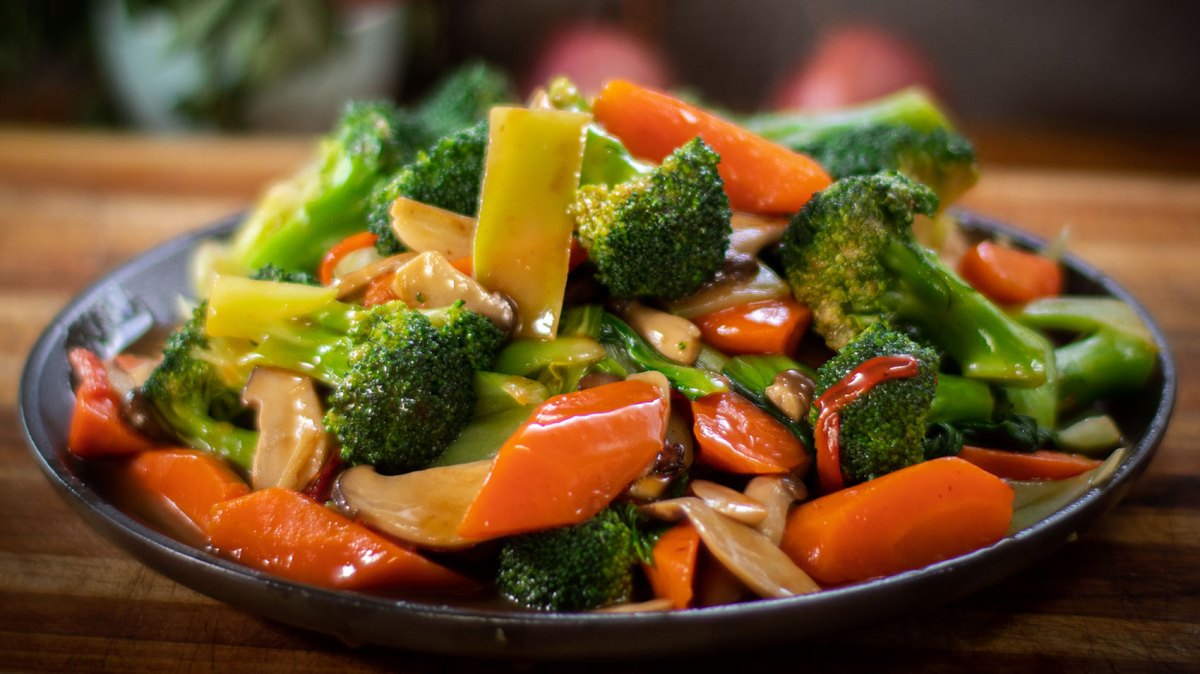Embark on a culinary adventure as we unveil the secrets to crafting vibrant and flavorful Asian vegetarian stir-fries. This guide delves into the art of stir-frying, exploring essential ingredients, masterful techniques, and diverse sauce profiles. From the fragrant breath of the wok to the perfect balance of sweet, sour, salty, and spicy, we’ll transform simple vegetables into a symphony of textures and tastes. Prepare to discover regional variations, innovative substitutions, and visually stunning presentation ideas that will elevate your vegetarian cooking to a whole new level.
We’ll journey through the process step-by-step, from selecting the freshest produce and protein alternatives like tofu, tempeh, or mushrooms, to mastering the high-heat techniques that create that signature wok hei. Learn to build delicious sauces, balancing flavors to perfectly complement your chosen vegetables, and discover the secrets to achieving perfectly cooked vegetables with vibrant colors and textures that pop. This isn’t just about recipes; it’s about understanding the culinary artistry behind creating truly exceptional Asian vegetarian stir-fries.
Essential Ingredients and Substitutions
Mastering the art of Asian vegetarian stir-fries hinges on understanding the core ingredients and their versatile substitutions. A well-balanced stir-fry relies on a harmonious blend of textures and flavors, achievable through careful ingredient selection. This section will explore the key components and offer alternatives to cater to dietary needs and preferences.
Common Ingredients Categorized by Function
A typical Asian vegetarian stir-fry incorporates ingredients that fall into several key categories: vegetables, protein sources, and sauces. The vegetables provide vibrant colors, textures, and a range of nutritional benefits. The protein sources add heartiness and satiety, while the sauces bind the dish together and deliver a depth of flavor.
- Vegetables: Broccoli, bok choy, carrots, bell peppers, snap peas, mushrooms, onions, garlic, ginger. These provide a spectrum of colors, textures (crisp, tender), and flavors (sweet, savory, pungent).
- Protein Sources: Tofu (firm, silken), tempeh, seitan, edamame, mushrooms (shiitake, oyster, cremini), lentils. These offer different textures and nutritional profiles, adding substance to the dish.
- Sauces: Soy sauce (tamari for gluten-free), oyster sauce (vegetarian oyster sauce available), hoisin sauce, rice vinegar, sesame oil, chili garlic sauce. These sauces provide umami, sweetness, acidity, and spice, creating a complex flavor profile.
Ingredient Substitutions and Flavor/Texture Impacts
Many ingredients can be substituted based on availability, dietary restrictions, or personal preferences. However, it’s important to understand how these substitutions might alter the final flavor and texture.
- Tofu for Tempeh: Replacing tofu with tempeh adds a more earthy, fermented flavor and a slightly chewier texture. Firm tofu provides a similar texture to tempeh, while silken tofu is softer.
- Soy Sauce Alternatives: For those with soy allergies, tamari (wheat-free soy sauce) or coconut aminos offer similar salty, umami notes. Coconut aminos have a slightly sweeter taste.
- Mushroom Variety: Shiitake mushrooms bring a deep, earthy flavor, while oyster mushrooms offer a more delicate, seafood-like taste. Cremini mushrooms provide a more common, mild mushroom flavor.
- Vegetable Substitutions: The possibilities are vast! Feel free to experiment with seasonal vegetables, keeping in mind that some vegetables will require longer cooking times than others.
Nutritional Comparison of Protein Sources
The following table compares the nutritional values (per 100g serving) of some common vegetarian protein sources. Note that these values are approximate and can vary depending on the specific brand and preparation method.
| Protein Source | Protein (g) | Calories | Fiber (g) |
|---|---|---|---|
| Tofu (firm) | 8-10 | 70-80 | 2-3 |
| Tempeh | 18-20 | 190-210 | 8-10 |
| Shiitake Mushrooms | 2-3 | 30-40 | 2-3 |
| Lentils (cooked) | 9-10 | 115-125 | 7-8 |
Mastering Stir-Fry Techniques
Stir-frying, a cornerstone of Asian cuisine, is all about speed, high heat, and the masterful control of ingredients. The goal is to achieve that elusive *wok hei*, a smoky, slightly charred flavor that elevates a simple dish to something truly special. This involves understanding the interplay of heat, ingredients, and technique. Mastering these elements will transform your vegetarian stir-fries from ordinary to extraordinary.
The essence of a successful stir-fry lies in meticulous preparation and a precise understanding of timing. Prepping all your ingredients before you even turn on the heat is paramount. Think of it like an orchestra – each instrument (vegetable) needs to be ready to play its part at the exact moment. This ensures even cooking and prevents some ingredients from becoming overcooked while others remain underdone. The order in which you add ingredients also plays a crucial role in achieving optimal texture and flavor.
Maintaining High Heat and Achieving Wok Hei
High heat is fundamental to stir-frying. Imagine a roaring inferno in your wok; this intense heat quickly sears the vegetables, locking in their vibrant colors and creating that desirable *wok hei*. A properly seasoned wok, heated until a drop of water evaporates instantly, is the key. The intense heat creates a Maillard reaction on the surface of the vegetables, resulting in a delightful caramelization and a depth of flavor impossible to achieve with lower heat. The rapid cooking also preserves the vegetables’ crisp-tender texture. For a gas stove, a high-intensity blue flame is ideal. If using an electric stove, ensure your wok is suitably sized for maximum heat distribution. Keep the wok moving constantly to prevent scorching, ensuring all sides of the vegetables are exposed to the intense heat. The characteristic smoky aroma, the *wok hei*, is a testament to the mastery of this high-heat technique.
Ingredient Preparation and Order of Addition
Thorough preparation is essential. Vegetables should be uniformly cut into similarly sized pieces to ensure even cooking. Harder vegetables, like carrots and broccoli stems, require slightly more time to cook and should be added first. Delicate greens like spinach or bean sprouts should be added last, as they wilt quickly. This staggered approach ensures that every ingredient reaches its peak flavor and texture. A typical order might be: first, the harder vegetables (carrots, broccoli stems); then, the firmer vegetables (bell peppers, mushrooms); followed by the softer vegetables (broccoli florets, zucchini); and finally, the delicate greens and herbs. This strategic approach prevents overcooking the more tender vegetables while ensuring the harder ones are fully cooked.
Tips for Perfectly Cooked Vegetables
To achieve perfectly cooked vegetables with vibrant colors and optimal texture, remember these key points: Don’t overcrowd the wok. Overcrowding lowers the temperature and leads to steaming rather than stir-frying. Work in batches if necessary. Use a high-quality wok, preferably made of carbon steel, for optimal heat retention and distribution. Avoid washing the wok after heating; the residual oil and caramelized bits from previous cooking contribute to the development of *wok hei* in subsequent stir-fries. Finally, taste and adjust seasoning as you go. A dash of soy sauce, sesame oil, or rice vinegar at the end can brighten the flavors and enhance the overall taste. The end result should be vegetables that are tender-crisp, brightly colored, and bursting with flavor.
Presentation and Serving Suggestions

Elevating your vegetarian stir-fry from a simple meal to a culinary masterpiece involves thoughtful presentation. The visual appeal of your dish significantly enhances the dining experience, making it as enjoyable to look at as it is to taste. Consider the colors, textures, and overall arrangement to create a truly stunning presentation.
The artful arrangement of your stir-fry on the plate is key to a visually appealing presentation. Think beyond simply piling everything into a bowl.
Plating Techniques and Garnishes
A vibrant stir-fry deserves a vibrant presentation. Imagine a bed of fluffy white jasmine rice, artfully mounded in the center of a shallow bowl. Drape the colorful stir-fry over the rice, allowing the vegetables’ hues – the deep green of broccoli, the fiery orange of bell peppers, the rich brown of mushrooms – to cascade attractively. A sprinkle of toasted sesame seeds adds a textural element and a subtle nutty aroma, while a few finely chopped cilantro sprigs provide a pop of fresh green and a delicate, herbaceous scent. For a more sophisticated touch, consider a drizzle of a vibrant, glossy sauce – a light soy-ginger reduction or a sweet chili sauce – creating a visually appealing sheen and adding another layer of flavor. Alternatively, a scattering of thinly sliced red chilies adds a dash of color and a hint of spice, without overpowering the dish. Consider the shape and size of your serving dish; a wide, shallow bowl allows for a more expansive and visually interesting presentation compared to a deep, narrow one.
Accompanying Dishes
To complete the dining experience, consider serving your vegetarian stir-fry with complementary side dishes. Fluffy steamed jasmine rice provides a neutral base that absorbs the stir-fry’s flavors. Alternatively, a nest of thin egg noodles adds a different textural contrast and a subtle eggy flavor. For a more substantial meal, consider serving alongside crispy vegetable spring rolls or delicate steamed dumplings, offering a variety of tastes and textures. A simple side salad with a light vinaigrette can provide a refreshing counterpoint to the richness of the stir-fry. The combination of flavors and textures creates a harmonious and satisfying culinary experience.
Step-by-Step Recipe Presentation with Images
A visually engaging step-by-step recipe presentation can significantly enhance the cooking experience. Imagine a series of images accompanying the recipe instructions. The first image might show a beautifully arranged array of fresh, vibrant vegetables – broccoli florets, sliced bell peppers, shiitake mushrooms, and snap peas – ready to be prepped. The second image captures the process of stir-frying, showcasing the glistening vegetables in the wok, their colors intensified by the heat. The third image displays the finished stir-fry, artfully plated on a serving dish, garnished with sesame seeds and cilantro. The fourth image shows the complete meal, the stir-fry alongside a bowl of steamed rice and a side salad, creating a visually appealing and appetizing spread. Each image should be sharply focused and well-lit, highlighting the textures and colors of the ingredients. The use of natural light can enhance the visual appeal, making the food appear fresh and inviting. A consistent style and aesthetic across the images create a cohesive and professional-looking recipe presentation.
Creating delicious and visually appealing Asian vegetarian stir-fries is now within your reach. By mastering the techniques and understanding the principles of flavor balance Artikeld in this guide, you can confidently experiment with diverse ingredients and regional styles. Imagine the vibrant colors, the tantalizing aromas, and the explosion of flavors in each bite. From simple weeknight meals to impressive dinner party dishes, your stir-fry creations will be a testament to your culinary skills. So, gather your ingredients, embrace the heat of the wok, and embark on a flavorful journey into the heart of Asian vegetarian cuisine.
Commonly Asked Questions
Can I use frozen vegetables in stir-fries?
Yes, but ensure they are completely thawed and patted dry before adding them to the wok to prevent steaming. Frozen vegetables might require slightly less cooking time.
How do I prevent my stir-fry from becoming soggy?
High heat is key! Ensure your wok is screaming hot before adding ingredients. Don’t overcrowd the wok; work in batches if necessary. Properly prepped ingredients (dried vegetables, etc.) are also essential.
What are some good substitutes for soy sauce?
Tamari (gluten-free soy sauce), coconut aminos, or a combination of rice vinegar and seaweed flakes can provide similar umami flavors.
How can I make my stir-fry spicier?
Add chili garlic sauce, sriracha, finely chopped chilies, or a pinch of chili flakes to increase the heat level. Adjust to your preference.


